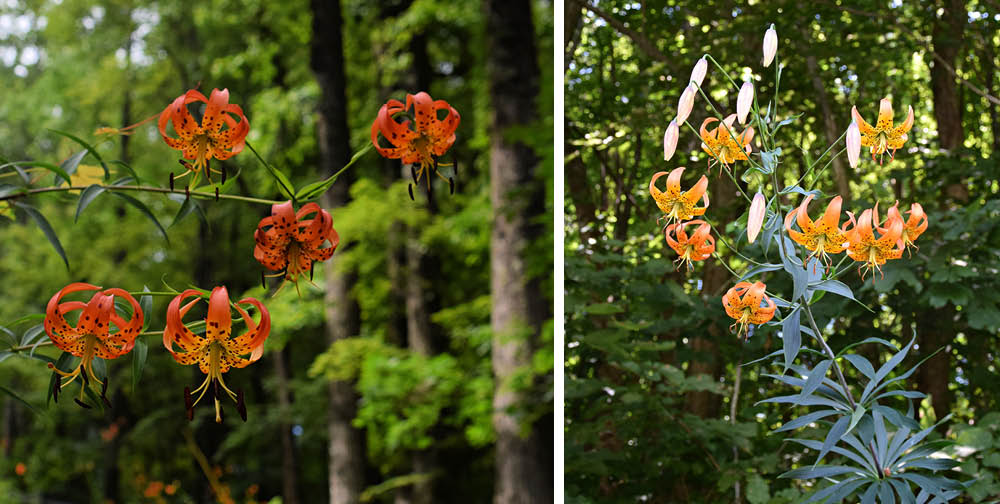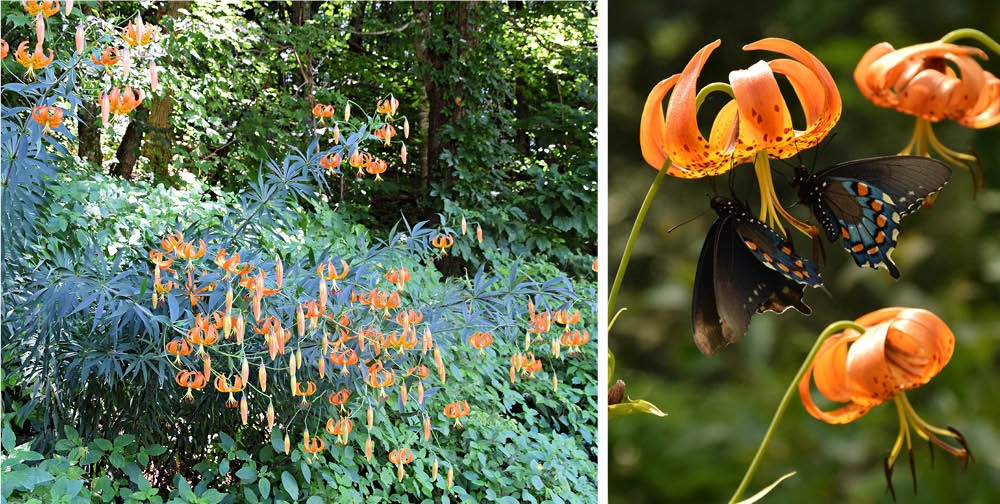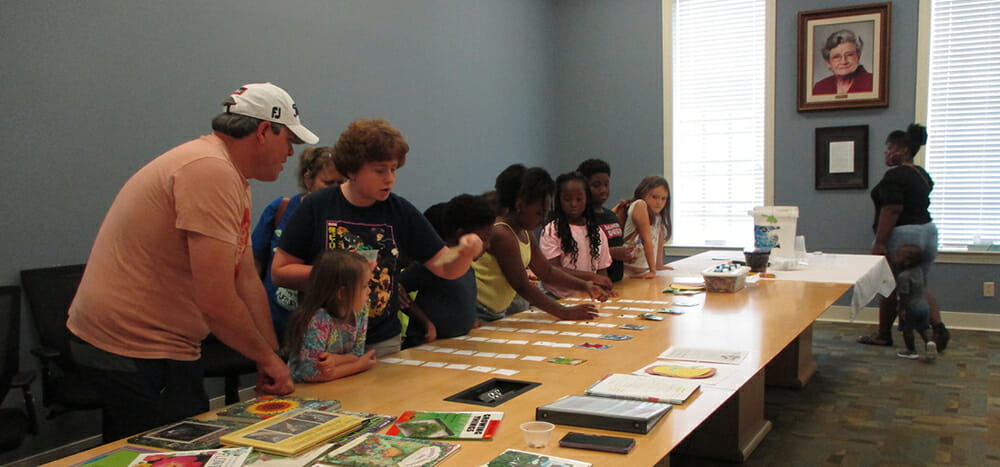
Happy Independence Day! The members of our patriotic threesome are scarlet beebalm (Monarda didyma), buttonbush (Cephalanthus occidentalis), and American bellflower (Campanulastrum americanum). Photos by Ellen Honeycutt.
In this issue ...
- Answers to common questions
- Membership milestone
- Spotlight on turk's cap lilies
- Chapter News
You've got questions... we've got answers
The most common questions we get from members, and from the public in general, include:
- What is this plant, and is it native?
- What's the best plant for ...?
- Is this plant diseased? Or is this insect damaging this plant?
- Where can I get native plants? And how can we increase their availability, in general?
- How do I remove [English ivy, privet, Japanese stiltgrass, ...]?
- How can I deal with [an HOA, a developer, a local government, ...]?
- What's a good landscaping plan for [my front yard, my eroding hillside, a local park, ...]?
The answers to all of these questions are central to our mission, and we are here to help. Sometimes, our answers are easily available and non-specific, while other times we strongly encourage you to seek assistance from professionals, because we want to support the growing industries related to native plants. Also, since specific situations are likely to require a visit to your site, and since GNPS has no paid staff, it makes sense to involve someone who can provide that personal attention.
But let's summarize some of the ways to get answers. Two Facebook groups often give the fastest answers in some areas, and although these are not operated by GNPS specifically, many of the key participants (including some group administrators) are affiliated with GNPS.
Specifically, those groups are a good place to start for questions 1 through 3 (pay attention to the FB group focus), and sometimes for advice in the other areas. Also, most chapters have a Facebook page, usually linked to their chapter page at https://gnps.org, which can provide some help in these area, as well as local information for question 4.
Information about specific plants (e.g., for questions 1 and 2) is available at our site either by simply using the search tool (the magnifying glass) in the upper right, or by browsing our Plant Library (from the menu: Georgia's Native Plants >> Plant Library..., and select the plant type). For a larger list of plants, we also encourage you to use other reputable sites such as wildflower.org, but pay attention to the native status relative to Georgia, and consider looking up more specific information about native status at the USDA PLANTS database or the Biota of North America Program.
But if you aren't already using them, start with these documents (as they pertain to your area), all of which are accessible on our educational materials page:
For question 4, we currently have a list of 44 nurseries that provide native plants, and nearly half of them sell primarily or totally native plants. How can you improve availability of native plants, in general? For starters, patronize these merchants and help their businesses grow. Others will see the opportunity and join. And if you have a favorite supplier, let us know. Before listing them on our site, will ask if they are selling any Category 1 or 2 invasives, and we will verify that they have a broad selection of high quality native plants.
Removing invasives (question 5) is a tough problem for all of us. Elbow grease and patience are key elements, as well as taking the opportunity to pull when the ground is wet. It can seem overwhelming at first, but note that even if you remove just 80% of an invasive plant on your property, and even if it increases by 50% in the rest of the year, if you continue to remove 80% each year, you will have less than 2% of the plant remaining in your property after its regrowth in the third year. But if you need help, we would like to provide a vetted list of contractors who have provided services to members, so pass any information you have to nativescape@gnps.org, and watch for a new page to appear under Resources & Research at our site.
Question 6 taps into a growing area of activity for GNPS, both at the state and chapter level. If you wish to be a part of our advocacy efforts, which will initially focus on local governments and HOAs, contact your local chapter or the state organization.
Understanding the best use of native plants in a particular outdoor space (question 7) takes some background in landscaping and experience with native plants. Don't hesitate to ask for quick advice, especially for small projects, but this is one of those areas where a professional can be well worth it in the long run. Our site provides a list of landscape designers who have been selected specifically for their ability to work with native plants. But if you are ready to get started by yourself, consider approaching your landscape in the following steps:
- Do you have non-native invasive plants? Those could be prioritized for first removal. Replace them with native plants.
- Do you have a lot of lawn? Reducing the lawn is a good way to get space for more productive plants (especially since it is often a sunny area that is perfect for flowering native plants).
- Do you have old landscaping that is in need of renewal? Replace it with native plants appropriate for the conditions (sunny, shady, wet, dry, sloped).
- Take inventory of what you have — you may already have some great native plants.
- To avoid the perception of a "messy" landscape, embrace the concept of "Cues of Care," which includes intentional signs that "an area is being managed purposefully and not neglected," in the words of one advocate, Jennifer Ceska. Search for "cues of care" or "cues to care" for more resources.
Membership Milestone
We proudly announce that the Georgia Native Plant Society has reached a membership of 1,532, an all-time high for the organization! This milestone would be impossible without the commitment of chapter and state leadership and, most importantly, you, the members. Thank you for supporting GNPS!
Plant Spotlight: One Superb Lily
Ellen Honeycutt
 Left: Turk's cap lilies (Lilium superbum) at Black Rock Mountain State Park. Right: Plant structure, showing buds, blooms and foliage.
Prior to the disruption of in-person activities by the pandemic, I enjoyed going to the Cullowhee Native Plant Conference for many years. In addition to the presentations, one reason that I enjoyed going was so that I could see some of the beautiful wild plants on the Blue Ridge Parkway, including the superb lilies known as turk’s cap lilies (Lilium superbum). They are in full bloom on the Parkway during that 3rd week of July (and certainly earlier).
In the deep, rich, moist roadsides of the Parkway, the stems of this lily reach 10-12 feet tall. Each stem is festooned with multiple orange blooms, and the stem leans out towards the road for best light. Swirling around them are dozens of pipevine swallowtail butterflies. Behind the lilies are the woods where tall trees support the vines of the bigleaf Dutchman’s pipe (Aristolochia macrophylla), the host plant for these butterflies.

Left: A clump of Lilium superbum on the Blue Ridge Parkway, weighted by blooms and surrounded by pale jewelweed (Impatiens pallida). Right: Pipevine swallowtails visiting a lily.
These lilies grow in Georgia as well. I have seen them in the wild mostly in north Georgia at several of the state parks there. Fingers crossed that mine, which were grown from seed by a friend, will bloom this year. I started the year with 6 stems but four of them were cut off by burrowing critters. My advice is to plant the bulbs with sharp gravel in the hole (Permatil is a good product). Look for these and other native lily species at native nurseries or online where you can buy them as bulbs.
You can read more about Georgia’s native lilies in an earlier blogpost of mine. And if you’re up for a nice roadtrip in July, read more about my visits to the Blue Ridge Parkway in this blogpost. I even give you the mile marker location for the best lily spot.
Chapter News

The Tiftarea Junior Gardeners work on completing a seed / flower packet matching activity during their first meeting at the Tifton-Tift County Public Library.
Coastal Plain Chapter
One of our newest CPC members, Ky Tanton, has begun the process of forming a garden club for young people, ages 7 - 17, in Tifton. The first meeting of the Tiftarea Junior Gardeners was June 18, with 9 young people (and parents) in attendance. CPC member Marilynne Marshall is helping Ky in this process.
Ky is a student at ABAC, planning to pursue a career in agronomy. Ky has been an active CPC volunteer, helping at plant sales and assisting with kids’ native plant activities at Camp OSCAR at the Okefenokee Swamp Park. Her newest project is working with the young gardeners to create a native plant pollinator garden at the Tifton-Tift County Public Library. The library staff applied for funding for the garden from the Georgia Public Library Service in partnership with the Rosalynn Carter Butterfly Trail. Marilynne Marshall plans to help her apply for additional assistance to complete the project from the Coastal Plain Chapter GNPS and the Magnolia Garden Club of Tifton. The garden will be registered on the Rosalynn Carter Butterfly Trail.
North Georgia Mountains Chapter
The first plant sale of the North Georgia Mountains chapter took place on Saturday, June 25th at the Union County Farmers’ Market in Blairsville. It has been an interesting process, corralling members who have plants to donate, determining the prices without prior experience, and guessing at things like hanging our banner. Hopefully we have learned what we need to in order to make next year’s sale less stressful!
The chapter meeting in June included a fabulous presentation by Mark Warren on the indigenous uses of native plants, with many attendees using the opportunity to buy his books as well. There won’t be a regular business meeting and presentation in July or August. Instead, on July 22nd at 10am, we will be gathering at the top of Brasstown Bald (the highest point in Georgia) to learn about the regional aquifers from Callie Moore with MountainTrue, followed by a narrated walk back down to the parking lot to learn about the native plants along the way. The number of attendees is limited to fifteen at a time, so if you plan on attending please RSVP to Teryn Romaine (tsromaine@gmail.com). If needed, we can add a second run at noon.
North Metro Atlanta Chapter
The North Metro Atlanta Chapter had a plant ID walk on June 25th. Join them for their next educational event, Native Plants of the Cherokee, at the Alpharetta Library on August 13th at 10:30AM featuring author Mark Warren talking on how some of the most common native plants and trees were used by the Cherokee for food, medicine, insect repellent, crafts, shelter and fire. |